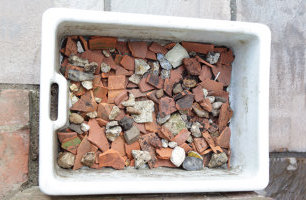Pak Choi is grown for its tasty leaves which are superb when added to stir fries and salads.
The taste is similar to that of mild cabbage and spinach and is a popular addition to many oriental dishes.

Herbs and herb growing has become an almost national pastime in the UK with more and more people having a go at growing a whole variety of spicy, fruity and aromatic plants. The best part is they are so easy to grow and whether you grow them for their leaves, stems, roots or seeds, they are extremely rewarding. Most herbs are grown for culinary purposes and plants such as mint, thyme and sage will always be highly popular amongst cooking enthusiasts. Some herbs are grown as annuals and some are biennials and some are perennial. Some need lots of space while others you can grow in relatively small confined areas.
One of the most common containers used for growing a variety of herbs is the old Butler sink. This is a large, heavy square sink that used to frequent many a country home, albeit downstairs in the kitchen or the scullery. Its name is derived from the days when part of a butler’s duties included washing the dishes and cleaning the family silver, which was done in the downstairs kitchen sink. Many of the old sinks have since been thrown away or otherwise discarded in favour of more modern designs but the old sink still has its uses.
These days Butler’s and Belfast sinks are much sought after as they make perfect containers for growing herbs. Due to their thick, glazed finish they are able to withstand the very worst of weathers so are ideal for outdoor use. Quite often they will be placed near the back door or kitchen door, where they can be quickly and easily accessed, making it very convenient to just pop out and pick a few herbs while making the Sunday lunch. However, not all herbs are suitable for growing in a sink as some herb plants require lots of room or prefer to spread their roots far and wide.
Smaller herbs such as thyme are best because you will be able to fit more varieties into a sink but also herbs like mint, which can be quite invasive, are suitable because they will be better contained. Chives, oregano, lemon balm and sage are also suitable along with coriander, basil and lovage. You can of course restrict your choices to only those you are likely to use most often. Also, you don’t need to have a sink to grow herbs. You can grow them in any suitably large pot or container. Troughs make good herb planters as do large buckets.
Chervil leaves are picked for use for flavouring salads and stuffings.....
Average Contents : 300 seeds
Best Coriander for growing in Pots and Containers.....
Av. Packet Contents : 300 seeds
A sink obviously has a drain hole, which will need to be covered, not plugged, just covered with broken crocks ideally, because the container needs to be able to drain away excess water. Use a gritty, well-drained soil to ensure the sink does not become waterlogged. A quality potting compost mixed together with well-rotted organic matter is ideal. You may also want to feed your herbs during the growing season but don’t overdo it. Soft new leaves will not contain as much aroma or oils as older, more mature leaves.

We have several old butler sinks that we use as herb planters near the kitchen door, very handy for popping out mid-recipe for a few leaves of this or that.
We're currently planting up another herb sink. Here’s the essential layer of broken crocks and stones for drainage. The sinks obviously have a plug hole, but it's important not to allow that to get blocked so a layer of stones and crocks does that.
Of course you don't need an old sink, any container or pot can be used for your herbs. They look very attractive by the back door step, on the patio, or wherever you have a spare few inches. Sinks, pots and other containers are also useful for keeping invasive herbs like mint and lemon balm in check. Our sinks usually have mint, chives, oregano, lemon balm, and sage. We put the thyme, parsley, more chives, tarragon, dill and comfrey straight out into the garden and allotment.
In an ideal world, your confined herb garden would be just perfect if it was situated right outside the kitchen or back door. However, this is not always possible and besides, you need to think about how much light the herbs will be exposed to. Many herbs that are grown for their aroma or flavour will need to be exposed to sufficient hours of sunlight. Also, herbs that are grown for their flowers or seeds will need enough sun to be able to ripen the seeds properly. It is estimated that at least 4 hours of sunlight is required although 6-8 hours is much better.
Whether you intend to use your herbs regularly or not, it’s always a good idea to keep them trimmed and not allow them to sprawl all over other neighbouring herbs. It is after all a mini garden so it needs a little care and attention now and then. You can of course pick leaves and flowers and dry them for use later. If you intend to grow herbs for their seeds as with coriander, then timing is everything. Wait until the seeds have fully developed and dried before harvesting. It’s also a good idea to remember to water your herbs regularly as containers dry out very quickly, especially during the warm summer months.
For a selection of herb varieties see: Herb Seeds
All blog content on this page is copyright of Simplyseed and is not to be reproduced without prior written permission. ©